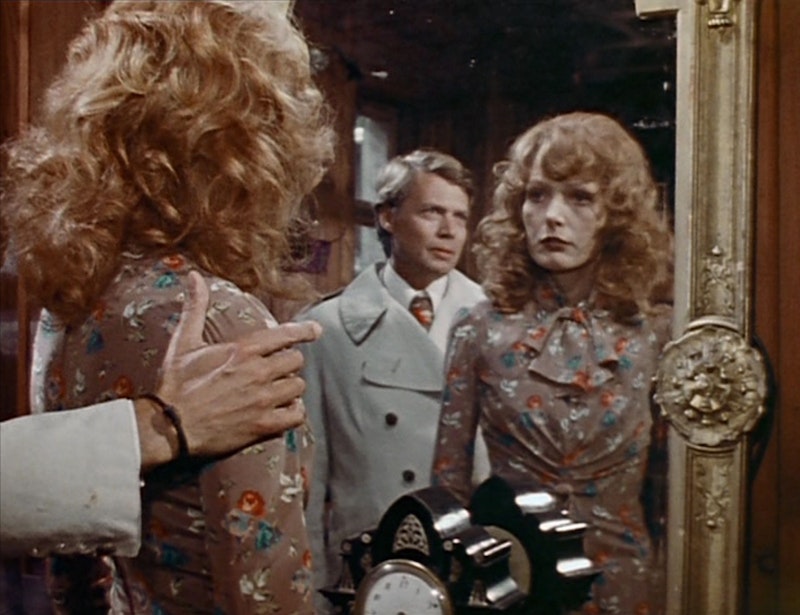It’s relatively easy to depict a relationship between a sadist man and a masochist/victim woman in a way that retains both as two-dimensional characters with hardly any humanity or depth. This isn’t the case with Rainer Werner Fassbinder’s film, Martha (1973). Not only is the film draped in nuances of what constitutes a victim and a perpetrator in an abusive relationship, it also functions on many different levels. Like a great symphony, each movement reveals and conceals something about the human condition but is essentially about one thing: imprisonment. It involves personal imprisonment, which has nothing to do with the society-at-large; imprisonment thrust upon us by the societal norms and expectations; and parental imprisonment.
A woman in her early-30s is vacationing in Rome with her father. Her name is Martha Heyer (Margit Carstensen), and her life appears to be dominated by domineering people, mainly men. Her status as a victim and perhaps even a masochist is established in the opening shot: the phone is incessantly ringing—it’s her father commanding her to come to the hotel lobby—and in the midst of this command, a man enters into the room, implying a sexual encounter. Martha feels helpless. She weakly attempts to get rid of the man, suggesting she has the power over him and that she’s not that kind of person who has random sexual encounters. The appearance of morality is important to Martha.
Martha and her father take a stroll and go up the Spanish Steps, and in that moment, her father suffers a fatal heart attack. Like a frightened and abused child, trapped in a woman’s virginal, spinster body of a dull librarian, Martha cries out: “My handbag has been stolen!” as if the obvious death of her father means nothing. In that moment, her father’s death signals the arrival of a wholly new existence—free woman—yet this is a pure lie. She’s fully aware of this metaphysical contradiction, which makes her character both hate-worthy and pitiable, but never eliciting compassion.
The lie and pain of her life continues after the death of her father and it’s foreshadowed by an encounter with a man, Helmut Solomon (Karlheinz Böhm), a sadistic engineer who has already decided that it’s he who has the control over Martha’s destiny. In a brilliant 720-degree camera shot, Martha and Helmut become joined together without ever touching one another.
At first, Martha rejects the advances of Helmut to marry him. You can call it courtship, if your idea of it involves standing close to a woman and whispering in her ear how unattractive and skeletal she looks, and who emits bad body odor. Martha’s both repelled and attracted by Helmut’s approach, and because of this nuance Fassbinder creates, we’re not really sure whether this is a reciprocal relationship or purely a relationship based on Helmut’s incredible domination.
To be sure, Helmut does tell her what to do: drink tea, instead of coffee; eat cornflakes, instead of eggs; listen to Orlando di Lasso, instead of Donizetti; smoking on the verandah instead of in the house. The list goes on. Helmut’s a tyrant, whose only intention is to enact a complete metaphysical takeover of Martha. But does Martha have any choice at all? Is the bourgeois society that Fassbinder seems to be implicitly criticizing simply not allowing her to be free? Or is it something entirely internal, such as how Martha was raised and thus, accepting an entirely identical pattern of relationship with Helmut?
It’s not easy to answer these questions because the beauty of Fassbinder’s work is that he never lets you know whether he’s being politically subversive or purely artistic. One could easily conclude that Martha is a satirical film, a commentary on the uselessness of bourgeois norms. Fassbinder makes fun of his characters. In one instance, Helmut’s sexually aggressive (most likely bordering on rape) toward Martha. We never see this moment, only an implication when Martha runs out of the bedroom, sobbing. Helmut, who has just shown his über-chauvinistic side, is wearing silk, polka-dot pajamas, an indication of a frivolous, vain, and silly man.
On the other hand, Martha is a horror story. The hand, which terrorizes Martha, is both visible and invisible. Helmut is a psychotic creep and the embodiment of the very society that Fassbinder is criticizing. Yet, I don’t think this is either an overtly or subversively political film. Fassbinder is primarily interested in the stylization of this disturbing condition (whether he personally sees it as disturbing is open to another debate since he was famously a tyrant on the set). The shots are framed in such a way that they serve as time stamps of meaning.
The camera focuses on particular facial expressions or words. However, for the most part, the disruption of time that the lens creates is driven by Fassbinder’s need to put his characters into yet another prison. There’s always another step into another movement of Martha’s destruction, until the final, devastating shot of Martha and Helmut. Has the obsession and possession been completed? Is Martha entirely subdued? Is she resigned? Or does she now, in her paralysis, have more power than Helmut can ever imagine? We don’t know, and that appears to be the point. Fassbinder’s artistic brilliance lies within the brutality and ambiguity of power.

